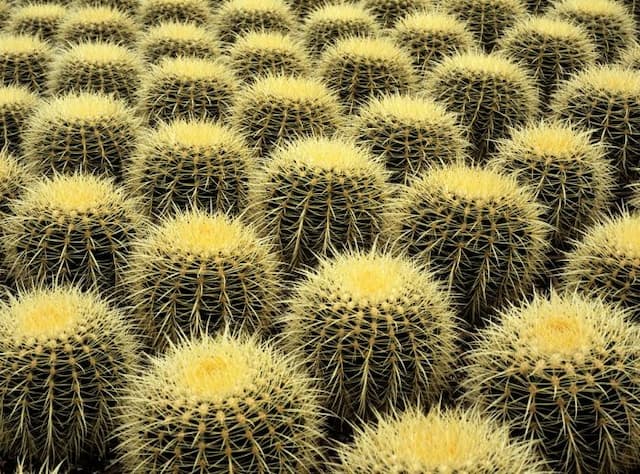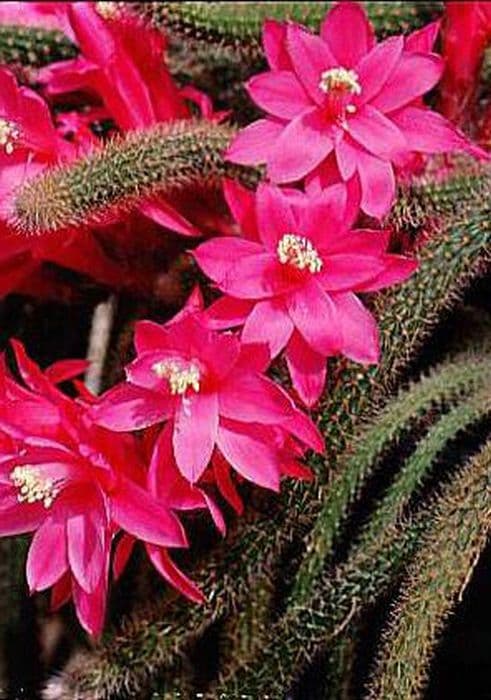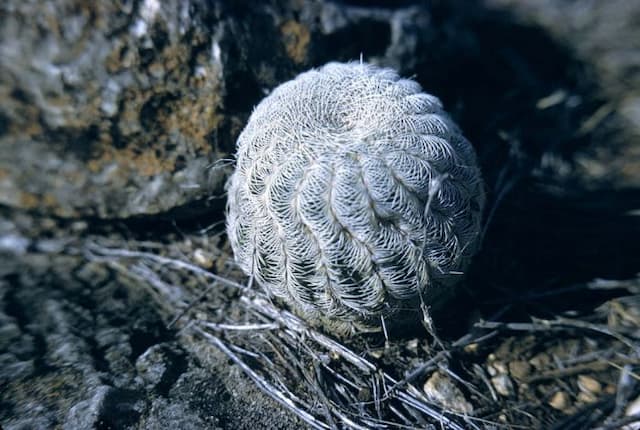Silken Pincushion Cactus Mammillaria bombycina

ABOUT
Mammillaria bombycina, commonly known as the Silken Pincushion Cactus, is a visually striking plant characterized by its spherical to slightly elongated shape. The surface of this cactus is densely covered with clusters of white silky hairs and sharp spines that emerge from areoles dotted across its surface. The spines themselves can vary in color, ranging from hues of yellow to reddish-brown, and are typically arranged in a radial fashion around the areoles, giving the plant its pincushion-like appearance. At times, the spines may also exhibit a hooked form. During blooming season, this cactus produces attractive flowers that add to its appeal. The flowers are generally a shade of pink or purplish-pink and form a contrast with the white hairs and spines, creating an eye-catching display of color. The blossoms emerge near the top of the plant in a circular, crown-like pattern, encircling the cactus. These flowers, once opened, reveal their bell-shaped form and enchanting beauty. After flowering, the plant may produce fruits, which are small and can carry a reddish hue that further adds to the vibrant display. The stems of the Silken Pincushion Cactus can be solitary or may multiply to form clusters, giving the appearance of a compact mound with age. The plant's overall texture is a result of the interplay between the soft, downy hairs and the more rigid, fierce spines, providing a unique tactile and visual experience for the observer. Despite the absence of references to its specific size, this description provides an insight into the charm and allure of the Mammillaria bombycina, making it a desirable addition for enthusiasts and collectors of unique cacti.
About this plant
 Names
NamesFamily
Cactaceae
Synonyms
Silken Pincushion Cactus, Silk Pincushion, Bombycina Cactus
Common names
Chilita bombycina, Ebnerella bombycina, Neomammillaria bombycina.
 Toxicity
ToxicityTo humans
The Mammillaria bombycina, commonly known as the Silken Pincushion Cactus, is not considered toxic to humans. However, it is important to handle it with care due to its sharp spines, which can cause physical injury if touched. Ingesting any part of the cactus is unlikely to cause poisoning or toxic reactions, but it may lead to gastrointestinal discomfort due to the plant's fibrous nature.
To pets
The Silken Pincushion Cactus is generally not toxic to pets; however, its spines can cause physical harm if a pet comes into contact with them. If a pet ingests the spines or any part of the cactus, it could lead to mouth or throat irritation and potential gastrointestinal upset. It's essential to keep this cactus out of reach of pets to avoid any injuries or discomfort.
 Characteristics
CharacteristicsLife cycle
Perennials
Foliage type
Evergreen
Color of leaves
Green
Flower color
Pink
Height
6 inches (15 cm)
Spread
12 inches (30 cm)
Plant type
Cactus
Hardiness zones
9
Native area
Mexico
Benefits
 General Benefits
General Benefits- Ornamental Value: Mammillaria bombycina, commonly known as the Silken Pincushion Cactus, is prized for its attractive appearance, sporting a cluster of spines and silk-like hairs, often used as a decorative plant in homes and gardens.
- Drought Resistance: As a cactus, it is highly adapted to arid environments, making it a low-maintenance choice for gardeners with limited water resources or those seeking drought-tolerant plants.
- Easy Propagation: This cactus species propagates easily from offsets, which allows enthusiasts to quickly and simply expand their collection or share with others.
- Compact Size: The Silken Pincushion Cactus remains relatively small, making it a suitable plant for indoor growing, such as on windowsills or in terrariums, where space is limited.
- Attracts Pollinators: During blooming season, the flowers of Mammillaria bombycina can attract pollinators like bees, contributing to the ecological health of your garden.
- Long Lifespan: Cacti generally have long lifespans, which means that with proper care, Mammillaria bombycina can be a long-term companion.
- Pest Resistance: It has a natural resistance to many pests that commonly affect other houseplants, reducing the need for chemical pesticides.
- Low Fertilizer Requirement: Mammillaria bombycina does not require frequent fertilization, making it a low-maintenance option for those new to planting or those who prefer minimal care routines.
- Therapeutic Hobby: The process of caring for this plant can provide a therapeutic and rewarding hobby, offering a sense of accomplishment as it grows and thrives under your care.
 Medical Properties
Medical PropertiesThis plant is not used for medical purposes.
 Air-purifying Qualities
Air-purifying QualitiesThis plant is not specifically known for air purifying qualities.
 Other Uses
Other Uses- Mammillaria bombycina, commonly known as the Silken Pincushion Cactus, can serve as living art by being incorporated into succulent arrangements or terrariums due to its unique and aesthetic appeal.
- This cactus can be used in educational settings, such as biology classes, to demonstrate plant adaptations to arid environments and to promote interest in botany and horticulture.
- The spines of the Silken Pincushion Cactus can be used in traditional crafting, for example weaving them into textiles to add texture and pattern.
- It can be used as an eco-friendly way to protect other plants by discouraging animals and pets from disturbing them due to its spiny exterior.
- This cactus serves as a thoughtful and low-maintenance gift option for those new to gardening or with limited time for plant care.
- The Silken Pincushion Cactus is utilized in landscape design in rock gardens and as accent pieces in arid or desert-themed gardens.
- Because of its compact size, the cactus is suitable for window sills and small spaces, providing a touch of greenery without occupying too much room.
- The bright flowers of the cactus can inspire artists and designers in creating colorful patterns and designs reflecting natural beauty.
- They are often used in feng shui practices as a symbol of endurance and self-protection, adding to the spiritual ambience of a living space.
- Enthusiasts may use this cactus as a subject for photography, capturing the intricate details of its spines and flowers.
Interesting Facts
 Feng Shui
Feng ShuiThe Silken Pincushion is not used in Feng Shui practice.
 Zodiac Sign Compitability
Zodiac Sign CompitabilityThe Silken Pincushion is not used in astrology practice.
 Plant Symbolism
Plant Symbolism- Protection: Mammillaria bombycina, commonly known as the Silken Pincushion Cactus, is covered in spines, which in plant symbolism often represent protection and defense against negativity or harmful forces.
- Resilience: As a cactus, the Silken Pincushion represents the ability to endure and thrive in harsh, challenging conditions, symbolizing toughness and the capability to overcome difficulties.
- Conservation: Due to the various threats that cacti face, such as habitat loss and illegal collection, the Silken Pincushion Cactus could symbolize the importance of conservation and the preservation of natural habitats.
- Self-sufficiency: Like many cacti, the Silken Pincushion can store water within its stems, which symbolizes self-reliance, independence, and the ability to provide for oneself without external assistance.
- Beauty and Awe: The stunning flowers that bloom on the Silken Pincushion Cactus symbolize the unexpected beauty that can arise in adverse environments and the ability to appreciate natural wonders even in desolate or challenging circumstances.
 Water
WaterFor the Silken Pincushion Cactus, water thoroughly when the top inch of soil feels dry to the touch, typically every 7 to 10 days during the active growing season in spring and summer. In winter, reduce watering to once a month or less, allowing the soil to dry out completely between waterings, to mimic its native desert habitat's conditions. When watering, use enough water so that it runs through the drainage holes, which might be around 8-16 ounces for a small to medium-sized pot, adjusting for the pot size and the environmental conditions.
 Light
LightThe Silken Pincushion Cactus thrives in bright, indirect sunlight and can tolerate direct sunlight. However, it's best to avoid the intense midday sun during the hottest part of the day to prevent sunburn. A south-facing or east-facing window is an ideal spot for this cactus, providing ample light without the risk of too much heat.
 Temperature
TemperatureThe ideal temperature range for the Silken Pincushion Cactus is between 70°F and 80°F during the growing season. It can tolerate a minimum temperature of 50°F, but frost or prolonged exposure below this can be harmful. In winter, cooler temperatures around 55°F to 65°F can help induce dormancy, which is beneficial for the plant's health.
 Pruning
PruningPruning the Silken Pincushion Cactus is rarely necessary, as it maintains its shape naturally. If needed, prune to remove any dead or damaged spines or to control size, using tongs and gloves to handle the spines. The best time for pruning is in the spring, before the active growth phase begins.
 Cleaning
CleaningAs needed
 Soil
SoilThe Silken Pincushion Cactus thrives in a well-draining cactus mix with coarse sand or perlite. The ideal soil pH is slightly acidic to neutral, around 6.0 to 7.5. A combination of one part potting soil, one part coarse sand, and one part perlite or pumice is optimal.
 Repotting
RepottingThe Silken Pincushion Cactus should be repotted every two to three years or when it outgrows its pot. It’s best to repot during the growing season, spring or early summer, to minimize stress on the plant.
 Humidity & Misting
Humidity & MistingThe Silken Pincushion Cactus prefers a dry environment with low humidity. It thrives in typical indoor humidity levels around 40-50%. Avoid high humidity environments, as they can lead to rot and fungal diseases.
 Suitable locations
Suitable locationsIndoor
Place in bright, indirect sunlight and avoid overwatering.
Outdoor
Full sun to partial shade; protect from heavy rain and frost.
Hardiness zone
9b-11 USDA
 Life cycle
Life cycleMammillaria bombycina, commonly known as the Silken Pincushion Cactus, begins its life cycle as a small seed, which when sown in well-draining soil and with adequate warmth, will germinate. The seedling stage involves the development of a small, globular green body armed with spines, and this juvenile stage is characterized by slow growth as it establishes a root system. As it matures into an adult, the cactus takes on a more cylindrical shape and can produce offsets or "pups" around its base, thus propagating asexually. The Silken Pincushion Cactus may bloom with pink or purple flowers in the spring or summer once maturity is reached, usually after several years of growth. Following pollination by insects or other means, the flowers give way to small, club-shaped fruits that, upon drying, release seeds to begin a new life cycle. Over time, with proper care, Mammillaria bombycina can live for decades, continuing its cycle of growth, blooming, and seed production.
 Propogation
PropogationPropogation time
Spring to Summer
The most popular method of propagation for the Silken Pincushion Cactus (Mammillaria bombycina) is by seeds or by offsets. When propagating by offsets, the best time is during the warmer months, typically in the spring or early summer when the plant is actively growing. Offsets, which are the small cacti that grow around the base of the parent plant, can be gently twisted off and allowed to dry for a few days to form a callous on the cut surface. Once calloused, the offsets can be potted in a cactus potting mix and kept in a bright, warm place without direct sunlight. It’s essential to let the soil dry out between waterings to avoid root rot. With proper care, these offsets will establish their own root systems and grow into new, individual plants.









